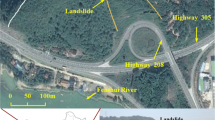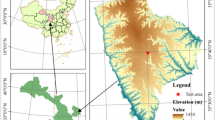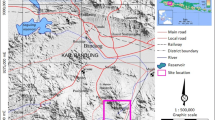Abstract
In saturated soils, drainage systems are one of the most effective remedial measures against slope instability due to their capacity to reduce pore-water pressure in the subsoil, increasing the shear strength of the soil. Due to their relative cheapness, subsurface drainage systems are widely used, also in combination with other stabilization works. Moreover, they provide a suitable solution to stabilization in a large number of cases, even when the landslide is very deep and structural measures are not effective (Popescu (2002) Landslide causal factors and landslide remedial options. Keynote lecture. In: Proceedings of the third international conference on landslides, slope stability and safety of infra-structures, Singapore, pp 61–81). In this paper the main subsurface drainage systems are described in terms of their conventional and innovative technologies, their limits and advantages. The design approaches in the relevant literature are also reviewed.
Access this chapter
Tax calculation will be finalised at checkout
Purchases are for personal use only
Similar content being viewed by others
References
American Society of Civil Engineers (ASCE) (2005) Pipeline design for installation by horizontal directional drilling. ASCE manuals and reports on Engineering Practice No. 108
Beer P, Hegg U, Manassero V (1992) Landslide stabilization at Ancona, Italy, by deep drainage wells. In: 6th international symposium on landslides, Christchurch, 10–14 Feb, pp 663–670
Bromhead EN (1984) An analytical solution to the problem of seepage into counterfort drains. Can Geotech J 21(4):657–662
HDD Consortium (2004) Horizontal directional drilling good practices guidelines. ISBN: 1-928984-13-4. North American Society for Trenchless Technology
D’Acunto B, Urciuoli G (2006) Groundwater regime in a slope stabilised by drain trenches. Math Comput Model, Pergamon-Elsevier Science LTD, 43(7–8):754–765
Desideri A, Miliziano S, Rampello S (1997) Drenaggi a gravità per la stabilizzazione dei pendii. Hevelius Edizioni, Benevento
Di Maio C, Santagata P, Viggiani C (1986) Analisi del processo di consolidazione indotto da un sistema di trincee drenanti. Atti XVI Convegno Nazionale di Geotecnica, Bologna, vol 3, pp 283–289
Di Maio C, Evangelista A, Viggiani C (1988) Analisi dell’efficienza di sitemi di dreni tubolari. Rivista Italiana di Geotecnica 12(4): 187–199
Hutchinson JN (1977) Assessment of the effectiveness of corrective measures in relation to geological conditions and types of slope movement (general report). Bull Int Assoc Eng Geol 16:131–155
Italdreni, Divisione di Greenvision ambiente S.p.A (2002) Trincee drenanti con il sistema “Twindrain” Prodotti geosintetici per il drenaggio dei terreni, Documentazione tecnica
Kenney TC, Lau KC (1984) Temporal changes of groundwater pressure in a natural slope of nonfissured clay. Can Geotech J 21(1):138–146
Kenney TC, Pazin M, Choi WS (1977) Design of horizontal drains for soil slopes. ASCE J Geotech Eng Div 103(GT11):1311–1323
Leoni F, Manassero V (2003) Consolidamento e rinforzo dei pendii in terra. Atti del XIX Ciclo di Conferenze di Geotecnica di Torino (CGT 2003)
Manassero V (2001) Il consolidamento dei pendii mediante drenaggio profondo. Convegno su rilevamento e tutela del territorio. Hydrogeo, Rimini, 9–11 May, Maggioli Ed., pp 483–496
Nakamura H (1988) Landslide control works by horizontal drainage works. In: Vth international symposium on landslides, Lausanne, vol 2, pp 495–500
Nonveiller E (1981) Efficiency of horizontal drains on slope stability. In: Proceedings of Xth international conference on soil mechanics and foundation engineering, Stockholm, vol 3, pp 495–500
Pellegrino A (1988) Misura dell’abbassamento della falda in presenza di aste drenanti. Convegno sul tema: cartografia e monitoraggio dei movimenti franosi. CNR Consiglio Nazionale delle ricerche, Bologna, 10–11 Nov 1988
Pun WK, Urciuoli G (2008) Soil nailing and subsurface drainage for slope stabilization. Keynote paper in: 10th international symposium on landslides and engineering slopes, Xi’an, China, June 30–July 4 2008
Stanic B (1984) Influence of drainage trenches on slope stability. ASCE J Geotech Eng 110(11):1624–1635
Author information
Authors and Affiliations
Corresponding author
Editor information
Editors and Affiliations
Rights and permissions
Copyright information
© 2013 Springer-Verlag Berlin Heidelberg
About this chapter
Cite this chapter
Urciuoli, G., Pirone, M. (2013). Subsurface Drainage for Slope Stabilization. In: Margottini, C., Canuti, P., Sassa, K. (eds) Landslide Science and Practice. Springer, Berlin, Heidelberg. https://doi.org/10.1007/978-3-642-31319-6_74
Download citation
DOI: https://doi.org/10.1007/978-3-642-31319-6_74
Published:
Publisher Name: Springer, Berlin, Heidelberg
Print ISBN: 978-3-642-31318-9
Online ISBN: 978-3-642-31319-6
eBook Packages: Earth and Environmental ScienceEarth and Environmental Science (R0)




